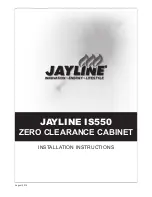
Initial Installation
QUALIFIED INSTALLERS ONLY
Vertical
Termination
Storm Collar
Flashing
Roofing nails
Elbow Strap
the exposed sections, bend
the support straps outwards,
and push the elbow strap
down to the roof level, as
shown in Figure 15. Tighten
the clamp around the pipe
section. Use a level to make
sure the pipe is truly vertical.
With roofing nails, secure the
support straps to the roof.
Seal the nails holes heads
with non-hardening mastic.
Trim the excess length of the
support straps that extend
out beyond the edge of the
flashing.
STEP 7.
Slip the flashing over the pipe
section protruding through
the roof. Secure the base
of the flashing to the roof
with roofing nails. Use a
non-hardening sealant between the uphill edge
of the flashing and the roof. Insure the roofing
material overlaps the top edge of the flashing as
shown in Figure 15. Verify that you have at least
the minimum clearance to combustibles at the
roof line.
STEP 5.
Cut hole in the roof centered on the small hole placed in the roof from Step 2. The hole should be of
sufficient size to meet minimum requirements for Clearance to Combustibles, as specified. Continue to
assemble lengths of pipe and elbows necessary to reach from the ceiling support box up through the roof
line. Galvanized pipe and elbows may be utilized in the attic, as well as above the roof line. The galvanized
finish is desirable above the roof line, due to the higher corrosion resistance.
STEP 6.
Once the pipe sections have been joined, and run up through the hole in the roof, slip an elbow strap over
Figure 15: Vertical Vent Termination Installation.
Table 3: Minimum ‘H’ for Figure 16
Roof Pitch
Minimum Height
Feet
Meters
Flat to 7/8
1
0.3
Over 7/12 to 8/12
1.5
0.46
Over 8/12 to 9/12
2
0.61
Over 9/12 to 10/12
2.5
0.76
Over 10/12 to 11/12
3.25
0.99
Over 11/12 to 12/12
4
1.22
Over 12/12 to 14/12
5
1.52
Over 14/12 to 16/12
6
1.83
Over 16/12 to 18/12
7
2.13
Over 18/12 to 20/12
7.5
2.29
Over 20/12 to 21/12
8
2.44
Figure 16: Height of Vertical Termination;
Reference Table 3.
13














































